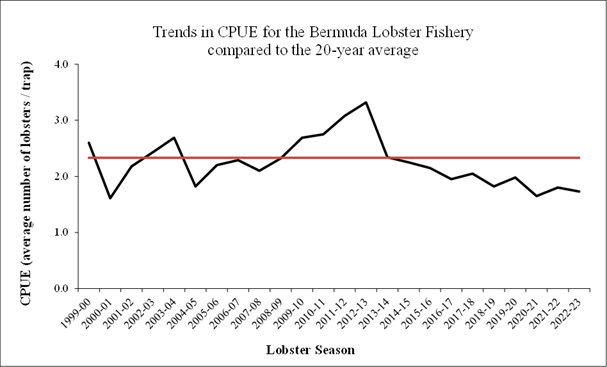Government On Bermuda’s Lobster Fishery
“Today, the 2023 lobster season begins, and while I understand and appreciate that in our culture, lobster dinners are a highly prized meal and an eagerly anticipated addition to restaurant menus during lobster season,” explained the Minister of Home Affairs Walter Roban.
“The extended period of below-average catch rates in the lobster fishery indicates a need to take immediate action to enable the future sustainability of the fishery and so the Bermuda government is putting in place steps and a programme for the replenishment of the lobster fishery.”
A Government spokesperson said, “Bermuda’s local spiny lobster [Panulirus argus] fishery has been a cause for concern within the Department of Environment and Natural Resources [DENR] for several years. When recent catch rates are viewed against more than 20 years of fisheries data, the current extended period of below-average catch rates is concerning. The information supporting this position has been shared with all the key stakeholders in the fishing industry over many years. There has been overall agreement that attention needed to be given to the state of the lobster fishery.
“Since 2016, there has been a notable reduction in the average number of lobsters caught per trap, referred to as catch per unit effort [CPUE]. This statistic is used to evaluate the status of fisheries worldwide because it is less affected by the number of vessels fishing or the number of traps they possess, as both may vary over time. The long-term average CPUE for Bermuda’s commercial spiny lobster fishery, based on 20 years of data, is 2.33 lobsters per trap. However, the CPUE has been consistently below this value for the past seven seasons. Although the differences might seem small, across the thousands of traps hauled, this amounts to a significant decrease in the total catch.
“In addition to tracking CPUE, DENR monitors the number of young, undersized lobsters [called ‘shorts’] that enter the traps but are later released. The number of shorts found in recent years has also declined. This combination of reduced catch rates and fewer young lobsters is driving concerns about the local lobster population’s status, concerns which fishermen and regulators share. The public has also noted the reduction in lobsters available to the local market.
“The following graph shows the overall catch per unit effort [CPUE] over time for the commercial spiny lobster fishery [1999-2023], compared to the 20-year average.
“The cause or causes of this decline in the spiny lobster population remain uncertain. The Caribbean spiny lobster has a complex life cycle, with larvae from around the region spending six to nine months in the open ocean, undergoing a series of developmental changes [see below photo of lobster larva].
“During each stage, the larvae require appropriate environmental conditions and sufficient food and remain vulnerable to predation. They also depend on ocean currents to transport them to suitable shallow water habitats, such as seagrass beds, mangroves and sheltered reefs, where they can settle and grow. A mismatch among any of these factors can reduce the supply of young lobsters to replenish Bermuda’s adult population. Other factors affecting the local spiny lobster population include parasites, diseases, and commercial and recreational fishing.
Photograph of a lobster phyllosoma [larva] found by a local fisherman in Bermuda waters [photo by JM Pitt]
“An improved understanding of the factors currently affecting the early life stages of Bermuda’s spiny lobster population is an essential first step to guide strategies such as seagrass bed restoration and providing artificial settlement structures that may help replenish lobster numbers.
“Regardless of what is causing the reduction in the size of the population, it is clear that there is a limited number of lobsters to go around. The Government is responsible for managing this resource to benefit all user groups, from the commercial and recreational fishermen to the stores and restaurants serving residents and visitors. The Government’s decisions around the lobster fishery must consider the biological, economic and social impacts.
“Therefore, recommendations were based on careful consideration of the catch and monitoring data from the commercial and recreational fisheries, the results of a formal statistical assessment of the local lobster population, reports from several sources [including commercial fishermen] as well as input and feedback from the lobster advisory committee, the Marine Resources Board, the Commercial Fisheries Council, and lobster fishermen.
“The policy amendments for the upcoming season, which traditionally runs from September 1 through March 31, will allow for all 22 currently licensed spiny lobster fishermen to participate in the fishery. However, there is a reduced trap allotment of eight traps per licence and an individual catch limit of 600 lobsters for the season. Furthermore, traps may only be set in offshore areas from September 1 through November 30 to ease pressure on the inshore areas.
“The public will also be aware that the number of recreational lobster diver licences available each season has been progressively reduced from the initial cap of 500 in 2017. This season, the number of lobster diver licences went from last season’s 340 down to 175. These actions are similar to those taken during the 2001/02 season when catch rates plummeted during the previous season. Catch rates improved in the subsequent years.”
Minister Roban continued, “These decisions intend to assist the lobster population. We are sensitive to the fact that members of our commercial fishing industry rely on seasonal lobster fishing as an important income supplement, and we want to ensure that commercial lobster fishing will remain economically viable. But despite our best efforts to address the needs of all, I appreciate that we cannot please everybody, and some will be disappointed in these decisions. However, failing to act now would be irresponsible, as any further reduction in the lobster population could make future recovery efforts even more difficult.”
“These policy amendments are in line with the continued practice of adaptive fisheries management that was put in place when this limited entry fishery began using the best available data, and the aim is to help rebuild our spiny lobster population to more robust levels so we can continue to enjoy a sustainable lobster fishery for all.”
“Lastly, it has been suggested that no lobsters will be available for sale until the fishers start putting out their traps. However, lobsters have always been imported to supplement the local catch. In 2022, 21,595 kg of lobsters were imported into Bermuda. Given our appetite for the delicacy, the fishers cannot catch enough lobsters to supply the needs of the restaurants and the public.”
“To avoid witnessing a further increase in the need to import lobsters, we must put in place a programme for replenishing the lobster fishery.”
Read More About
Category: All, Environment, News




Gov needs to close the lobster fisheries for a few years to recover. I used to dive but it’s not worth going out anymore. Hard to find them and everyone is saying the same thing. We lost the seagrass, lionfish are eating small ones, over fishing here and in the caribbean where most of ours hatch, rising sea temp and pollution. The commercial fishing guys blame the divers and the divers blame the pots. The pots are out 24/7, damage coral and risk of by catch. We protected the parrotfish and other species from no fishing and some have come back strong. Needs to be done asap.
Maybe rather than wasting any more effort or thought on a fish processing plant, there should be efforts made to create lobster and fish hatcheries. Far more productive and possibly the knowledge and facilities of BIOS and BAMZ could assist.